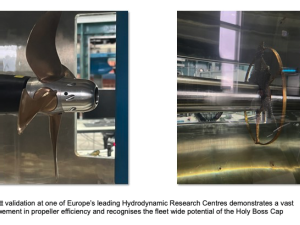Port directors don't typically see themselves as "heroes," but that distinction is now being bestowed upon executives of US Gulf ports as they lead their facilities, and the cities they serve, back to operation following devastation wrought during an unprecedented hurricane season.
At the 94th annual convention of the American Association of Port Authorities (AAPA), held Oct. 23-27 in Tampa, not only was Gary P. LaGrange, president and chief executive officer of the Port of New Orleans, among those referred to as a hero. He also had the distinction of being proclaimed a captain in the US Merchant Marine by John E. Jamian, acting administrator of the US Department of Transportation's Maritime Administration (MARAD).
According to LaGrange, hurricanes Katrina and Rita detrimentally impacted 22 ports, but the Port of New Orleans suffered most, sustaining more than $1 billion in damages. Some $275 million of that will not be covered by either insurance or the Federal Emergency Management Agency (FEMA), he noted.
Indeed, the storm destruction continued even as hundreds of port industry leaders from throughout the Western Hemisphere were meeting in Tampa as, some 250 miles to the south-southeast, South Florida's ports were being hit on Oct. 24 by Hurricane Wilma. This year's AAPA convention was scheduled for a bit later in the year than usual in hopes of avoiding hurricane impact, but this season has been far from typical.
LaGrange, who was concluding a year serving as AAPA's chairman in addition to his New Orleans duties, used the AAPA convention to laud the federal government for its response to Hurricane Katrina - and to urge officials in Washington to take steps to protect New Orleans, steps that, if taken before Katrina struck on Aug. 29, could have saved lives and property.
"This industry should be so very proud of the way our federal government reacted, contrary to what you may have heard and read," LaGrange said, speaking on a convention panel that included executives of three other ports that are continuing their recovery from Katrina.
LaGrange said the failure of levees that allowed the Crescent City to succumb to flooding was not the fault of the US Army Corps of Engineers, but rather the "blatant failure" of Congress and the Office of Management and Budget to furnish New Orleans with sufficient protection against flood waters. He said his No. 1 priority now is to work with Congress and the Corps of Engineers to ensure that a levee system to protect the below-sea-level city from a Category 5 hurricane is in place - a project that he said would cost $6.5 billion. To protect the entire region would cost $30 billion, he said.
Those in LaGrange's corner would appear to include Jamian, the acting MARAD administrator, who presented him with the captain certificate. Jamian commented that LaGrange has the support to be the next governor of Louisiana. He said, "This guy was unbelievable, a genuine hero. Gary's a hero now. He's known throughout Washington."
LaGrange presented an engraved clock to Jamian, whose personal familiarity with the port industry included a stint as executive director of the Detroit/Wayne County Port Authority.
Jamian said a key lesson learned from the recent hurricanes is that "we all could use a lot more coordination" between port authorities and other governmental entities.
Lessons learned, according to LaGrange, include the need to properly prepare for flood protection, increased awareness of the necessity of earlier mandatory evacuations, the importance of better-prepared shelters and medical and food supply resources, and a "better-prepared and schooled law enforcement contingent - in fact, a law enforcement contingent."
Ironically, LaGrange and other senior port officials rode out part of Katrina in the Hilton New Orleans Riverside - the same hotel in which the 2006 AAPA convention has been slated to take place from Sept. 10-14, 2006. By that time, LaGrange projected, 80% of the population of New Orleans will have r










